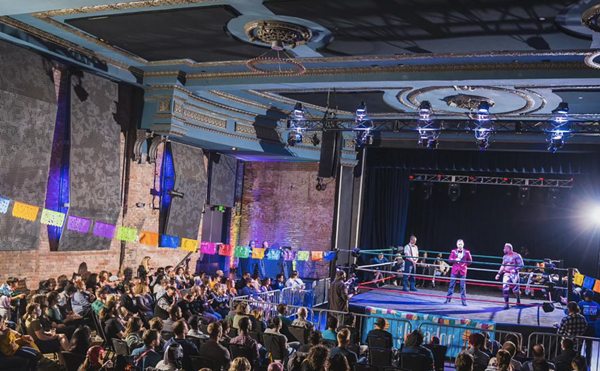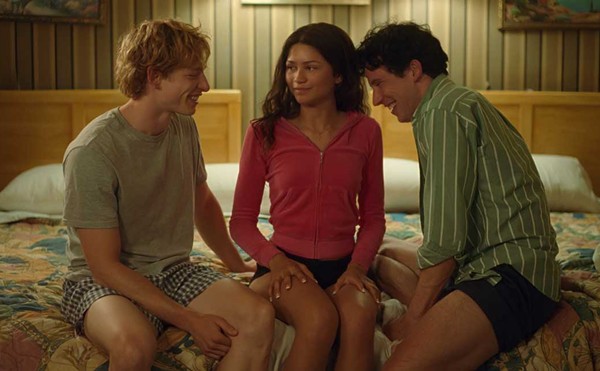According to Jewish mythology, in every generation there must be a quorum of Tzaddikim, or 36 righteous individuals to bring balance to the world. These 36 can't say who they are — according to some interpretations, they may not even know who they are — but without them, the world will descend into chaos.
Oak Park native Todd Weinstein started working on his visual interpretation of the myth in 1995, when he was in Germany to cover a celebration commemorating the 50-year anniversary of the end of World War II. "I kept asking myself what could've saved the world from World War II," he tells us by phone from his home in New York, where he now lives. "We knew that the Americans came, and the Russians came, and everybody showed up, but I was looking for something more poetic."
In Weinstein's take, the 36 righteous ones are sort of spirits that live among us. He gives the ancient tale a contemporary twist by photographing inanimate objects encountered on the street, anthropomorphizing say, a metal street sign, or a shadow, or a crack on the wall — creating the feeling that the 36 righteous ones are at once distant, but at the same time comforting, a force that might not be fully materialized in our realm, but whose presence is still felt. Weinstein expanded on the idea by shooting abstractions of the 55 recorded prophets of Jewish tradition as well.
He says he doesn't usually work with a plan, choosing subjects that draw him in. "I basically take a walk, wherever I am," he says. "I carry my camera all the time, and something will sort of speak to me."
He found his interpretation of Moses in the form of a cracked marble wall in New York. He says one time when his niece was visiting him, he stopped in his tracks as he walked out of her hotel. "'I said, 'That marble. I know that marble. I think this is where I photographed Moses,'" he recalls. "You know, there's a lot of walls in New York — I couldn't remember where I photographed it. I said, 'This is the wall. We gotta look around here.'" Sure enough, Weinstein was drawn back to the exact spot.
Weinstein's photos are currently on display at Farmington Hills' Holocaust Memorial Center. Titled Light Is My Voice, the exhibition includes his black-and-white shots documenting the re-emergence of Jewish life around the world from 1995-1999; his "36 Unknown," which spans from 1995-2001; and his take on the Biblical prophets, which spans from 1995 to the present. In all, there are more than 100 images on display.
"We need something today, man. There's so much shit going on — we need some sort of hope," Weinstein says of the notion of the 36 righteous ones. "Look at Detroit — it's been so tough on Detroit. But [it's] coming up, and it's surviving, and there's a lot going on there. There's a lot of good energy," he says. "It's really exciting that my show's premiering in Detroit, because I think it's in that spirit of not giving up, and being hopeful and moving on."
Weinstein moved to New York in 1970 at the age of 19, where he's lived ever since, but he says he likes to premiere his work in Detroit before he shows it elsewhere. In Detroit, his father ran the Mummp, a teen nightclub that used to routinely host acts like the Amboy Dukes and Mitch Ryder. "I've always been around music and artists," Weinstein says. "Growing up in Detroit was incredible, so I always try to bring my energy back there."
As a high schooler, Weinstein says before he found photography, he was in danger of dropping out. "I wasn't going to high school very much," he admits. "I was kind of bored. I'd get to the front door, and then I'd walk out and go back into my car and drive down to Plum Street, which was a famous hippie area where John Sinclair used to hang out. It was downtown, it was the real world."
Weinstein says his high school counselor recommended he check out the new darkroom in the art department, and he says he's been carrying his camera every day since. He got a break by becoming one of the first photographers for Creem magazine, and when he arrived in New York, he studied with the well-known photographer Ernst Haas, whom he worked with for the next 14 years.
"He was very instrumental in opening my eyes to allowing myself to explore an infinite amount of possibilities in creating something, not to be so heavy-handed on yourself and to allow something to come through you," he says of Haas, who encouraged Weinstein to just create. "By doing something, that's what creates your personality and your voice, and your style. It's through the doing of it — it's not so much intellectual."
Weinstein says his current show isn't really about him at all, but more of a combination of all of his mentors and influences. Anthony Morris, also originally of Detroit, designed all of the frames, and with the help of Larry Melkus and Visible Works Designs brought the series to life.
"In your own work, you try to develop your own sensibilities," Weinstein says. "You use all that influence and bring it into your own work. That's what that body of work is. It's every poem I've read, all the music music I've heard, all the people I've met in the world. It's a culmination of everything — I borrowed from everybody. I'd be lying to you if I said it's the most original thing you've ever seen, but it becomes personal because I'm not hiding any of that. I'm using it and I'm nourishing it and I'm bringing it into my own voice."
Light Is My Voice is currently on display at the Holocaust Memorial Center, 28123 Orchard Lake Rd., Farmington Hills; 248-553-2400; holocaustcenter.org. Runs through Dec. 22.






